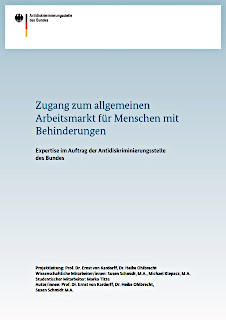Access to the general labour market for persons with disabilities
- Factsheet on the research project -
Authors: Prof Dr Ernst von Kardorff, Dr Heike Ohlbrecht, Susen Schmidt, published by the Federal Anti-Discrimination Agency (FADA) Year of publication: 2013
Brief overview
The empirical study examines mental barriers and prejudice which (severely) disabled and chronically ill persons have to face on the labour market, and it analyses them with consideration to structural and procedural impediments. Despite of far-reaching legal framework conditions, the employment situation of disabled or chronically ill employees has only slightly improved during the past few years. Therefore, barriers to the access to the general labour market are analysed in detail.
The qualitative study aims at pointing out to the mutual intersections which impede the access to the general labour market at various levels for persons with disabilities.
Method
Selected persons from the following target groups involved in this topic as well as stakeholders were interviewed by using different techniques of qualitative social research:
- Problem-oriented interviews with personnel managers, works councils and disabled-employee officers in private and public enterprises of different size (large, small and medium-sized enterprises and micro-enterprises), broken down into works exceeding the employment quota and having elaborated innovative integration schemes (Best Practice) and those which do not meet the required quota.
- Occasional interviews with severely disabled persons and/or chronically ill people about the experience they gained when looking for employment and in their daily work routine.
- Expert interviews with representatives from lobby groups to support the disabled, with employees associations as well as with integration offices and central welfare offices about their experience gained in counselling and job placements.
Group discussions with a) representatives from science and practice, b) personnel managers from companies as well as c) severely disabled persons who are employed on the general labour market, looking for a job or working at a workshop for disabled persons.
Main results
Access to the labour market is extremely difficult for people with disabilities or chronically ill persons. These circumstances are particularly severe, since participation in working life ensures economic independence, social acceptance, status and self-esteem as well as social inclusion for people with disabilities. Enterprises which exceed the quota of disabled staff members and have elaborated innovative integration schemes, report about positive experiences with regard to motivation and improvement of the working atmosphere. It is true that a professional training and a tailor-made vocational qualification are the prerequisites for being hired and employed, both for people with disabilities or chronically ill persons and also for non-disabled persons. However, even if disabled persons present their training and qualification certificates, they will face considerable obstacles in their access to the labour market. These are based on information and perception deficits and, last but not least, on a variety of prejudice about e.g. their working capacity and employment options. Among the large variety of persons with disabilities, those with a physical handicap have the best chances of being integrated into the working environment - insofar as their handicap is not highly striking; people with psychic disorders and/or mental health problems or with severe behaviour disorders have the slightest chances. They are met with great prejudice and behavioural uncertainty.
In conclusion, the study points out to:
Socio-psychological barriers
Although, as a rule, enterprises gain extraordinarily positive experience with disabled people or chronically ill persons as employees, the employers continue to have a broad range of reservations and partly massive assumptions of deficits. In many cases, there is a lack of preparedness for inclusion, and frequently this issue is not considered as a strategic task. As a result, people with disabilities repeatedly experience discrimination in job application procedures and at their workplace.
Institutional barriers
Access to the labour market is also rendered more difficult for disabled or chronically ill persons, because the workflow is not geared to the needs of staff members with disabilities or because there are fears of coming into contact with them. What matters is an active involvement of the disabled and the joint search for imaginative solutions. Moreover, now as before, there is still a lack of information and, especially of awareness with regard to the range of possible employments, the efficiency and toughness of people with disabilities or chronically ill persons. Frequently, there is also a lack of knowledge about special aids in cases of particular disabilities and diseases.
Structural barriers
The structure of the regional labour market and the difficult labour market situation on the whole render the employability of (severely) disabled persons more difficult. Consequently, from the point of view of disabled persons, an increase in the employment rate would lead to improved opportunities of integration. A specific disability management of companies and job placement agencies would also contribute to overcoming structural barriers.
In general, all three kinds of barrier lead to an exclusion of people with disabilities or chronically ill persons from participation in working life.
Options for action
- Elaboration of an index for inclusion for the world of work, framing standards in accordance with the UN Convention on the Rights of Persons with Disabilities, which are binding for enterprises and the placement agencies.
- Bringing up the issue of the situation of (severely) disabled employees on the labour market and easier access to information.
- Revision of the term ‘severely disabled persons' which does no longer only cover the degrees of disability, but is rather supportive of ascertaining the individually required kinds of assistance and takes into account individual needs for the purpose of inclusion in the labour market.
- Improved information on employment options for people with disabilities by those who already participate in the working life and may act as ‘ambassadors’ for other employers.
- Assistance in vocational reintegration of people with (severe) disabilities ‘from one source’, since a multitude of problems becomes evident in particular at the transitions from unemployment to work or when returning to one’s job after a rehabilitation.
- Improved information, encouragement and empowerment of the target groups.

